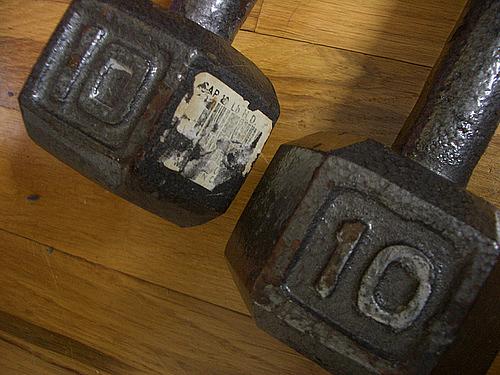Pumping Iron During Chemo

Exercise is good for cancer patients, doctors these days say. That’s an about-face from just a decade ago when they urged patients to conserve their flagging energy. My oncologists tell me to exercise as much as I can, as long as it’s not causing pain. Otherwise there are no limitations, no matter the patient’s age, type or stage of cancer.
I can understand that exercise may not be a priority for many cancer patients, in spite of evidence that those who do work out fare better than those who don’t. It wasn’t a priority for me until after I was diagnosed in March with lung cancer. I exercised regularly before my diagnosis, and suspect exercising is one way for me to reassert control and counter feelings of helplessness. Whatever the case may be, my exercise program makes me feel better physically and boosts my confidence, so it seems worth sharing.
I got a jump-start by my husband’s personal trainer, Erin, who offered me four free workout sessions while I underwent chemotherapy. After two weeks, I splurged on 10 more sessions, at $85 each, with Erin’s employer, GH School for Healthy Living. I considered this a necessity, not a luxury, because it had to do with my health. I wish my insurer saw matters this way, too: Insurance does not cover it.
I didn’t have a goal in mind when Erin and I first got together in May so she suggested that I aim not to lose muscle mass, as many patients do during chemotherapy. At the time, I had four cycles of chemotherapy in front of me. A common side effect of chemo is weakened muscles, so this seemed like a sensible goal.
Erin’s plan for me consisted of two, one-hour weight-lifting sessions each week at most, fewer if I didn’t feel up to it. The aim was to increase my energy, not sap it. She selects appropriate weights and varying numbers of repetitions for each set of lifts, adjusting the number of sets I perform depending on my energy level that day.
For instance, if I am doing curls for my biceps I am sometimes instructed to lift the weights on a count of two, and then count to five letting the weight back down, so the muscle remains contracted. Varying the exercises forces my muscles to adapt, which is what drives muscle development, she explains.
“If the muscle gets used to a routine and is doing the same thing over and over, there’s no need for it to change, develop, or improve,” she says. The training method is called “muscle confusion.”
The trainers at GH School teach pupils to isolate a muscle and keep it contracted during the entire exercise. This can make a 10-pound weight feel like 40!
GH School has analyzed the benefits of weight, or resistance, training for heart patients. They sought to find out if resistance workouts can boost cardiac function at least as well as cardiovascular training, which includes such exercises as running on a treadmill.
I still do cardiovascular work on my own time. Erin suggested I walk instead of jog as I did before, because I will derive the same benefit with less risk of injury. Each week I take several walks and play tennis twice. Usually I take one or two days off from all exercise each week, too.
Erin discourages me from overdoing it, but I am influenced by medical evidence that intense workouts are best for cancer patients. In August of 2012, researchers at the University of New Mexico published a review of 56 clinical trials and found that weight lifting, cycling, and yoga or quigong (an exercise that integrates physical postures with breathing techniques) improved patients’ quality of life and their physical and social functioning. It also lessened their fatigue.
Light workouts helped patients, but intensive training was even better, the study concluded.
I’ve stuck to what I would term moderate workouts over the past eight months. They have helped me get through four cycles of chemotherapy plus several rounds of maintenance therapy.
I never measured myself with one of those muscle mass tests, but I’d wager I have not lost any muscle. In fact, I think I might have gained some. I know I did not lose any weight, yet my clothes fit me differently, which may be due to built-up muscle in my upper body. I definitely feel a difference.
(I’m not sure what effect my drugs may have had on my weight. Some of my pain-killers are supposed to depress appetite while others, like the steroid, is supposed to stimulate appetite. Overall, I can’t really tell a difference in my appetite or eating habits.)
Another area needing more research is the impact of resistance training on the body’s immune system and its related effect on cancer patients.
Erin told me, “This is a relatively new area of scientific inquiry, and I think even the scientists are still puzzling through exactly what the mechanisms of interaction are between the immune system and skeletal muscle.”
Researchers in the Netherlands examined the impact exercise had on the immune function of cancer patients and found it was significant because of its role in reducing inflammation. They said various immune parameters improved after exercise, but additional research is needed. To read the full report, click here.
This post originally ran in the "Cancer In Context" blog and has been used with permission from Thompson Reuters.
Image by Seth W. via Flickr

